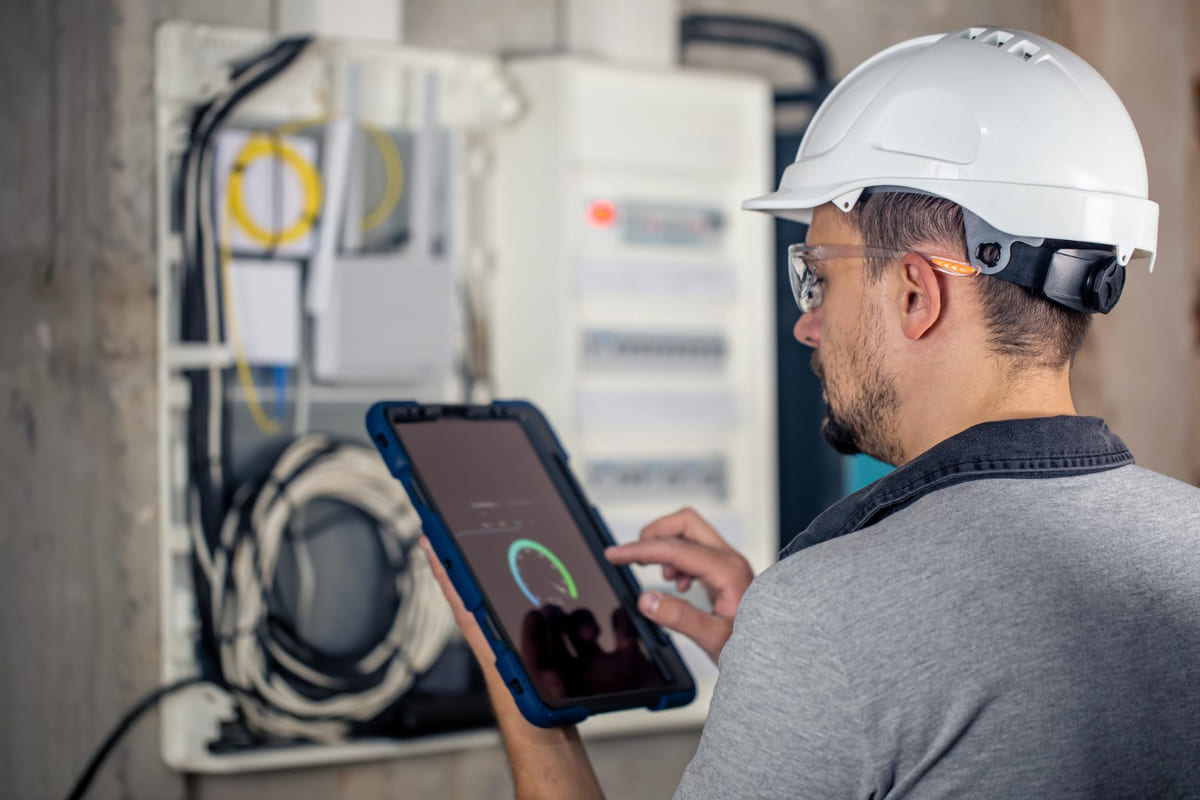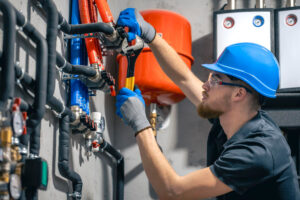Predictive maintenance using IoT is transforming how construction firms manage their equipment. By deploying smart sensors on machinery and structures, sites can continuously monitor conditions and address issues before they lead to failures. This article explores the top Predictive Maintenance IoT Use Cases in construction, starting with common maintenance problems and their consequences, then showcasing how various IoT sensors provide solutions.
Table of Contents
Problems and Consequences
Large construction sites around the world face maintenance challenges that can disrupt projects. Below we identify key problems – from surprise equipment breakdowns to inefficient servicing – and examine their impact on project timelines, costs, and safety.
Unplanned Equipment Failures and Downtime
Heavy equipment like cranes, excavators, and generators often operate for long hours under harsh conditions. Without warning, a critical machine can break down – for example, an excavator’s engine seizing or a tower crane’s hoist motor failing mid-lift. These unexpected equipment failures halt operations immediately. The consequences include:
-
Project Delays: Work comes to a standstill when a vital machine is down. Crews may sit idle for hours or days waiting for repairs. Tight construction schedules are derailed, and milestones are missed. A single crane breakdown could delay lifting operations by several days, pushing back the entire project timeline.
-
High Repair and Idle Costs: Emergency fixes for failed equipment tend to be costly. Companies pay for rush delivery of spare parts, overtime for repair crews, or rental of replacement machines. Meanwhile, the idle time of both equipment and labor incurs costs with no productive output. Industry experts note that unplanned downtime can consume 20–30% of a machine’s availability in poorly maintained fleets, eroding profitability.
-
Cascading Effects: One failure can create bottlenecks. If a concrete pump fails during a foundation pour, concrete deliveries might go to waste and subcontractors down the line are held up. Unplanned maintenance often has ripple effects across multiple teams and tasks on a construction site.
In short, reacting only after breakdowns means absorbing heavy time and cost penalties. It highlights the need for a more proactive approach to keep equipment reliable.
Suggested article to read: How Predictive Maintenance IoT Reduces Unplanned Downtime in Construction: 4 Case Studies
Inefficient Maintenance Scheduling
Traditional maintenance in construction is often done on fixed schedules (e.g. servicing every X weeks or Y operating hours) or on a reactive basis (fix after failure). Both approaches have drawbacks:
-
Under-Maintenance: If servicing intervals are too far apart or irregular, developing problems can go unnoticed. Components wear out between scheduled check-ups, leading to the very breakdowns preventive maintenance aimed to avoid. For example, a bulldozer might run for months without inspection, only to have a minor issue escalate into a major engine failure because it wasn’t caught in time.
-
Over-Maintenance: On the other hand, rigid schedules can result in unnecessary work. Some machines might be serviced too often or have parts replaced while still in good condition. This wastes technician time and spare parts, and it can introduce new issues (e.g. disturbing a well-running system). Unneeded downtime is also incurred for maintenance that isn’t actually required at that moment.
-
Inflexible Servicing Windows: Construction equipment usage can be unpredictable – some weeks a machine works non-stop, other times it’s idle. A fixed timetable might send a truck for maintenance in the middle of a busy period (causing avoidable downtime), whereas during a quiet period a needed check might not be scheduled. Inefficient timing means either lost productivity or increased risk of failure.
The consequence of inefficient scheduling is a suboptimal maintenance regime. Companies either overspend on maintenance for diminishing returns or they experience more breakdowns due to missed issues. In both cases, the construction process suffers – either from avoidable downtime or from higher likelihood of catastrophic failure. Studies have found that a large portion of routine preventive tasks add little value; in fact, up to 60% of scheduled maintenance activities may be wasteful or better handled by condition-based methods. This indicates significant room to improve efficiency by servicing equipment only when needed, based on real condition data.
Safety Risks from Poor Maintenance
When equipment isn’t properly maintained, safety hazards increase on the construction site. Machinery failures can pose immediate dangers to workers and bystanders. For example:
-
A worn-out crane cable or gearbox can snap or malfunction during a heavy lift, risking a dropped load or even a crane collapse. Such incidents can cause serious injuries or fatalities and damage surrounding structures.
-
Faulty brakes or hydraulic systems on heavy vehicles (like dump trucks or loaders) could fail to stop, leading to collisions or rollovers. Equipment operators and nearby crew are put in harm’s way.
-
Leaking fluids, overheating engines, or electrical faults not only threaten the machine’s health but also create fire hazards. An engine that isn’t running within safe parameters might catch fire, endangering people and property.
Beyond acute accidents, poor maintenance has cumulative safety effects. Workers might have to perform emergency repairs in dangerous conditions (e.g. under a suspended load or in bad weather) due to sudden failures. Moreover, an unreliable machine forces operators to improvise or take risks to meet deadlines, further increasing the chance of mistakes and accidents.
Regulatory and financial consequences follow safety incidents. Investigations may find that negligence in maintenance contributed to an accident, exposing the firm to legal liability, work stoppages, and reputational damage. Thus, maintenance issues aren’t just operational problems – they directly affect worker safety and regulatory compliance on site.
Unchecked, these problems result in a cycle of lost productivity, escalating costs, and unsafe conditions. The construction industry has long recognized that better maintenance can mitigate these issues. This is where predictive maintenance using IoT sensors comes into play, offering data-driven solutions to anticipate and prevent equipment problems.

Solutions with Sensors
Predictive maintenance leverages IoT sensor technology to monitor equipment health in real time and forecast when maintenance should be performed. Instead of waiting for failures or following a rigid schedule, sensors provide continuous data (vibrations, temperature, pressure, etc.) that analytics systems use to detect early warning signs. Maintenance can then be scheduled just in time – before a breakdown occurs but not too early to waste useful life. This approach directly addresses the problems outlined by minimizing unplanned downtime, optimizing service intervals, and improving safety.
Below are the top 7 predictive maintenance IoT use cases in construction, each centered on a specific sensor type or technique. These use cases illustrate how different sensors monitor machinery and structures to prevent failures. Real-world examples from global projects are included, showing successful deployment on both fixed machinery (like cranes and hoists) and mobile equipment (like excavators and trucks).
1. Vibration Sensors for Rotating Machinery
Use Case: Monitoring vibration patterns in rotating components (motors, engines, gearboxes, bearings) to catch mechanical issues early. Vibration sensors (accelerometers) attached to equipment can detect subtle changes in how a machine vibrates during operation. These patterns are key indicators of emerging problems such as imbalance, misalignment, or bearing wear.
-
What it Monitors: The sensor continuously measures oscillations and frequencies of moving parts. Healthy machines have a known vibration “signature.” If components begin to degrade – for instance, a bearing starts pitting or a shaft is slightly misaligned – the vibration signature shifts (e.g. an increase in amplitude at certain frequencies).
-
Preventable Failures: Abnormal vibrations can signal issues like loose bolts, bent shafts, gear tooth damage, or insufficient lubrication. By detecting these conditions early, maintenance crews can replace or repair the part before it fails completely. Without vibration monitoring, such issues might go unnoticed until a major breakdown occurs (for example, a gearbox seizing).
-
Example – Tower Crane Motor: In a London skyscraper project, tower cranes were equipped with vibration and temperature sensors on their hoist motors and gearboxes. Partway through the project, the IoT system flagged a slight increase in a crane motor’s vibration levels, suggesting a bearing was deteriorating. Maintenance was scheduled for the next non-working day. The team found and replaced a worn bearing in the motor, preventing a potential catastrophic failure. As a result, the crane avoided any unplanned downtime during critical lifting operations. This real-world case demonstrated how vibration monitoring kept the crane reliable and the project on schedule.
By continuously “listening” to machines, vibration sensors enable a shift from reactive fixes to proactive care. Construction equipment often operates in demanding, vibration-intensive environments (rough terrain, heavy loads), so this use case is fundamental. Many companies now deploy wireless vibration sensors on excavators, bulldozers, cranes, and even portable generators. The data is analyzed either on-site or sent to cloud platforms that use algorithms to differentiate normal operating vibrations from worrisome anomalies. Catching a developing problem through vibration analysis might mean, for example, changing out a $200 bearing in a planned maintenance window rather than having a $20,000 engine failure and multi-day outage later. This IoT use case directly targets the core issue of unexpected equipment failure.
2. Temperature Sensors for Overheating and Thermal Health
Use Case: Tracking the temperature of critical components (engines, hydraulic systems, electrical panels, bearings) to prevent overheating and detect stress. Temperature sensors (thermistors, infrared sensors, etc.) placed on or inside equipment continuously measure heat levels during operation.
-
What it Monitors: Key points include engine coolant and oil temperatures, exhaust temperatures, motor winding temps, hydraulic fluid temperature, and even brake or transmission temperatures. Unusual heat build-up is a classic sign of trouble – it may indicate friction (due to lack of lubrication or a misaligned part), an overworked component, or cooling system failure.
-
Preventable Failures: Overheating can quickly damage engines or mechanical parts. For example, if a loader’s hydraulic fluid gets too hot, it could indicate the hydraulic pump is straining or a filter is clogged, which if unaddressed might lead to pump failure. Temperature spikes in an engine could foreshadow a cooling system issue or internal wear. Electrical equipment running hot might suggest an overload or impending component burnout. By catching temperature anomalies early, crews can investigate and fix root causes (add coolant, replace a failing pump, clean filters, etc.) before permanent damage occurs.
-
Example – Fleet Vehicle Monitoring: A civil construction firm in the Netherlands fitted its fleet of 100+ machines with IoT telematics units that included temperature sensors on engines and transmissions. In one case, an IoT alert was triggered by an unusually high transmission oil temperature in a dump truck during operation. This early warning allowed the maintenance team to intervene and discover an impending transmission problem (degraded fluid and a worn part). The truck was pulled in for service over the weekend, the transmission issue was fixed, and it returned to work without ever experiencing the predicted breakdown.
This use of temperature sensors highlights how IoT-based thermal monitoring directly reduces unplanned downtime. Construction equipment often operates at the edge of performance – engines run in hot climates or under heavy load, and cooling systems are challenged by dust and debris. Continuous temperature tracking ensures that if, say, an excavator’s engine starts running hotter than normal under the same workload, maintenance can be scheduled to check it out before a failure or fire occurs
It also optimizes routine maintenance; for instance, rather than changing hydraulic fluid at fixed intervals, some projects use temperature and usage data to change fluid only when its thermal history suggests degradation. By keeping equipment within safe temperature ranges, sensors protect both the machine and the crew (preventing accidents like engine fires or blown hoses) and sustain productivity.
3. Oil Quality Sensors for Engine and Hydraulic Health
Use Case: Analyzing the condition of oils and lubricants in engines, gearboxes, and hydraulic systems to predict maintenance needs. Oil quality sensors can measure properties such as viscosity, contamination, moisture content, and the presence of metallic particles in real time as equipment operates.
-
What it Monitors: These sensors are installed in oil reservoirs or lines. They use techniques like dielectric sensing, optical detection, or magnetics to assess lubricant health. Key metrics include: particle count/ferrous debris (tiny metal shavings from wear), water content (which can cause corrosion or reduced lubrication), viscosity index (thickness of oil), and chemical composition (degradation products, acidity).
-
Preventable Failures: Changes in oil quality often directly indicate internal wear or impending component failure. For example, a spike in metal particles in a crane’s gearbox oil could mean gears are grinding or a bearing is failing, shedding metal. Water detected in hydraulic oil might come from a failing seal or condensation, reducing the oil’s effectiveness and risking damage to pumps and valves. By catching these signs, mechanics can perform targeted repairs or oil changes. It also prevents catastrophic outcomes – running an engine with metal-laden oil will lead to severe engine damage, and water-contaminated hydraulics can cause sudden loss of pressure or control.
-
Example – Excavator Hydraulic System: On a large infrastructure project, maintenance teams used oil condition sensors on the hydraulic systems of excavators and bulldozers. In one instance, an excavator’s sensor flagged an abnormal increase in particles in the hydraulic fluid of the arm actuator. The data suggested excessive wear in a hydraulic pump or cylinder. The team responded by inspecting the hydraulic circuit and found a pump beginning to fail internally. They replaced the pump and flushed the system before a major breakdown occurred. Without the sensor, the pump likely would have failed during operation, causing the excavator’s arm to lose function suddenly – a safety hazard and a source of lengthy downtime.
In addition to failure prevention, oil monitoring enables optimized service intervals. Instead of changing oil on a calendar basis, construction firms can perform oil changes or filter replacements when the sensor data indicates it’s truly needed (or before oil degrades beyond safe limits). This ensures equipment always runs with healthy lubrication, extending component life. It also avoids the waste and cost of premature oil changes.
For example, a generator on site can continue running on the same oil for an extended period if sensors show the oil is still clean and effective, whereas another generator operating in harsher conditions might get an earlier oil change when sensors detect contamination. Such condition-based maintenance keeps machines in peak condition and prevents the kind of silent wear-and-tear that eventually leads to unexpected failures.

4. GPS and Telematics for Usage-Based Maintenance
Use Case: Using GPS trackers and telematic devices on construction equipment to collect usage data (operating hours, duty cycles, location, idle time) and optimize maintenance scheduling. While GPS by itself provides location, in combination with onboard sensors and connectivity (telematics), it becomes a powerful tool for predictive maintenance logistics and decision-making.
-
What it Monitors: Modern telematics units act as an IoT hub on vehicles and machines. They often include GPS, engine hour meters, fuel usage sensors, and can interface with the machine’s computer. They log how long equipment runs, how hard it’s worked (e.g. load or RPM data), and in what conditions (location can correlate with environmental factors like dust or altitude). They can also record fault codes from the engine control unit and maintenance history. All this data is sent to a central platform.
-
Maintenance Optimization: By analyzing usage patterns, maintenance can be done when it’s truly needed rather than strictly by the calendar. For example, if a backhoe loader has been operating nearly 10 hours every day and in rough terrain, its wear rate will be higher – the system might schedule maintenance sooner (like a preventive check after a certain number of engine hours or cycles) compared to an identical backhoe on a less intense duty cycle. GPS data can also help coordinate where to service equipment – for instance, scheduling a field service visit to a remote site when multiple machines there are due for maintenance, reducing travel downtime.
-
Preventable Issues: Telematics often includes alerting features. If a machine exceeds certain thresholds (e.g. an excavator’s engine hours since last service, or a high number of idle hours indicating potential operator misuse or a problem like frequent stalling), maintenance managers get notified. Location tracking can prevent maintenance oversight – machines won’t “get lost” on far-flung sites and miss their service. It also helps in cases of environmental exposure; for instance, equipment working in extremely dusty locations might need air filter replacements more frequently – telematics data combined with environmental info can flag this need.
-
Example – Fleet Management in Infrastructure Projects: The Dutch contractor mentioned earlier integrated telematics across their entire fleet. Every piece of equipment streamed data on engine performance, usage hours, and location to the manufacturer’s analytics center. By doing so, the company shifted to a predictive maintenance model at scale. One outcome was that they could consolidate maintenance activities: if data showed that five excavators at a highway jobsite each had about 50 hours left before needing service, they would plan a single maintenance shutdown to service all five together at an optimal time (say, a planned lull in work or night shift), rather than dealing with each separately after it had failed or timed out.
Telematics and GPS don’t directly measure a physical failure mode like vibration or temperature do, but they are the information backbone of predictive maintenance. They ensure that data from all other sensors is centralized and analyzed in context. They also add a layer of intelligence: knowing when and how equipment is used helps predict when components are likely to wear out. For construction staff, the benefit is better coordination – they know which machines need attention and when, avoiding both last-minute emergencies and redundant servicing. In essence, this use case turns maintenance into a well-scheduled, location-aware operation that dovetails with construction planning (e.g., performing maintenance when a machine is at a convenient location or during off-peak project periods).
5. Load and Strain Sensors for Structural Safety
Use Case: Measuring loads, stresses, and strains on construction equipment and temporary structures to predict fatigue or structural failures. Load cells, strain gauges, and pressure sensors can be installed on critical load-bearing elements – such as crane booms, cables, lifting hooks, scaffolding, or hydraulic supports – to monitor the forces they experience in real time.
-
What it Monitors: These sensors capture how much force or deformation an element is under. For example, a load sensor on a crane hook measures the weight of each lift; strain gauges on a crane’s jib or tower measure bending and stress; tension sensors on a cable measure stretching; pressure sensors on a hydraulic jack indicate the load it’s supporting. By logging these metrics, an IoT system knows the cumulative stress each component has endured and can detect overload events or unusual stress patterns.
-
Preventable Failures: Structural components usually fail after prolonged cycles of stress or one-time overloads beyond their capacity. If a tower crane repeatedly lifts near its maximum load, its structural connections and welds accumulate fatigue. Strain sensor data can reveal if parts of the crane are being stressed beyond safe limits or if there’s a gradual increase in strain during normal loads (which might indicate a developing crack reducing stiffness). Early warning might be an increase in deflection of a crane boom under a known load, pointing to weakening. Similarly, in a construction hoist, load sensors can detect if the hoist is being overloaded by excessive weight – allowing intervention before a cable snaps or motor fails.
-
Example – Smart Crane and Structural Monitoring: Consider a high-rise building site using a tower crane and a hoist. The crane is fitted with strain gauges at critical joints and a load cell on the hook, while the hoist has sensors monitoring cable tension and motor load. Throughout operations, these devices feed data to the site’s IoT platform. In one real case, a tower crane in Stockholm showed gradually increasing strain readings on its slewing ring (the rotating base) during normal lifts. This was a red flag that the slewing bearing was wearing out. Maintenance crews scheduled a brief shutdown to inspect and lubricate the bearing and ended up replacing a worn component.
Beyond machinery, structural health monitoring during construction is another facet of this use case. For example, sensors on temporary supports or formwork can warn if loads exceed design, helping prevent collapses. Even after construction, infrastructure like bridges can benefit (as seen with the Queensferry Crossing bridge in Scotland, which was outfitted with over a thousand sensors including strain gauges and accelerometers to continuously “listen” to the structure).
In that case, the IoT system detected anomalies like excessive strain on support cables and allowed engineers to fix issues before any damage occurred, drastically reducing unexpected closures. In general, load and strain sensor use cases underscore that predictive maintenance isn’t only about engines and hydraulics – it extends to the very frameworks and structures that equipment operates on, ensuring safety and stability through constant monitoring.
6. Ultrasonic Sensors for Wear and Leak Detection
Use Case: Using ultrasonic sensing and acoustic monitoring to detect issues that produce high-frequency sound or vibration beyond the range of human hearing. Ultrasonic devices can pick up on phenomena like material cracks forming, leaks (air or fluid), or lubrication problems, providing an additional predictive maintenance tool especially in detecting faults that other sensors might miss.
-
What it Monitors: Ultrasonic sensors and portable ultrasound devices “listen” for high-frequency signals emitted by equipment. Examples include: the ultrasonic hiss of air or hydraulic leaks, the friction sound of a dry or under-lubricated bearing, or the crackling noise of electrical discharge (arcing) in switchgear. They can also be used in thickness gauging – sending ultrasonic pulses through metal to measure if a structural element has thinned due to wear or corrosion.
-
Preventable Failures: Many mechanical issues begin with subtle ultrasonic signatures. A small compressed air leak in a pneumatic system may not be audible to the human ear amidst a noisy jobsite, but an ultrasonic sensor can pinpoint it – saving energy and preventing that leak from growing and causing a pressure drop that halts tools or machinery. In heavy equipment, if a bearing is inadequately lubricated, it will generate ultrasonic noise before vibrational changes become severe; catching this early means a simple re-greasing avoids a bearing failure.
-
Example – Leak and Component Inspection: A global construction firm implemented an ultrasonic monitoring program on their large earthmoving machines (bulldozers and wheel loaders). Small wireless ultrasonic sensors were placed near hydraulic hose fittings and valve blocks. During operation, these sensors listened for the high-frequency signature of fluid leaking under pressure. On one bulldozer, the system alerted the team to a probable leak in the main hydraulic circuit. Upon inspection, mechanics found a hose starting to develop a pinhole leak, evidenced by a fine mist of hydraulic fluid – not yet enough to drop pressure significantly, but it would have worsened.
Ultrasonic sensing is sometimes called the “ears” of predictive maintenance, complementing the “eyes” (visual inspections and cameras) and other IoT senses. In construction environments, where noise is constant, having sensors tuned to specific ultrasonic frequencies helps cut through the ambient roar and catch specific problems. This use case is particularly valuable for maintenance personnel as a diagnostic aid. Even if not permanently installed on every machine, routine ultrasonic scans of equipment can be part of a predictive maintenance plan – much like a doctor uses ultrasound to find issues inside a body. It allows detection of problems invisible to normal sensors, thereby adding another layer of prevention against equipment failure and downtime.

7. Pressure Sensors for Hydraulic and Pneumatic Systems
Use Case: Continuous monitoring of pressure in fluid power systems (hydraulic circuits, pneumatic lines, fuel systems) to detect leaks, blockages, or component degradation. Pressure sensors and transducers installed on equipment provide real-time readings of fluid pressure, enabling the detection of abnormal drops or spikes that indicate faults.
-
What it Monitors: In hydraulics, sensors measure pressure at key points like pump outlets, hydraulic lines, and actuators. In pneumatics or compressed air systems, they monitor air pressure in supply lines or reservoirs. For fuel systems, pressure sensors can monitor fuel rail pressure in engines. These readings are typically very stable during normal operation (within expected ranges when an implement is idle vs. when lifting a load, etc.). The IoT system logs the pressure trends and can identify deviations.
- Preventable Failures: A drop in hydraulic pressure could mean a leak in the system or a failing pump unable to maintain output. A gradual decline over time might indicate seal wear in cylinders or a slow leak, whereas a sudden drop signals something like a hose burst or major leak (immediate shutdown needed). A pressure spike, on the other hand, might occur if a valve is stuck or a line is blocked, putting stress on components. By catching abnormal pressures, the system prevents scenarios like: an excavator’s hydraulic brake failing because fluid leaked out, or a concrete pump’s hose bursting due to pressure surge. It also helps optimize performance – if sensors show pressure not reaching the expected level.
- Example – Concrete Pump and Excavator Hydraulics: On a megaproject, a concrete pumping machine was outfitted with pressure sensors along its pump and boom cylinders. During one operation, the IoT dashboard showed one of the boom cylinder pressures was fluctuating outside the normal pattern (losing pressure faster than others). This signaled a possible internal leak in that cylinder’s sealing. Maintenance scheduled an inspection after that day’s pour and indeed found a worn seal in the cylinder, which they replaced overnight. The pump resumed work the next day without any downtime during critical hours – importantly, they avoided a potential mid-operation failure where the boom could have lost pressure and dropped, causing a safety incident.
Pressure sensors effectively give equipment a way to “self-check” the strength and integrity of their fluid systems. Hydraulic systems are the lifeblood of many construction machines (cranes, excavators, loaders, lifts), and failures often manifest as pressure anomalies. By instrumenting these systems with IoT pressure monitoring, maintenance teams gain instant insight into leaks or performance loss. They can respond by tightening fittings, replacing seals or hoses, or fixing pumps well before the machine loses functionality.
This leads to improved reliability and safety – for example, preventing an aerial work platform from suddenly losing hydraulic pressure while elevated, which could be dangerous. Additionally, consistent pressure readings ensure machinery is operating at peak efficiency, as any deviation can be addressed promptly. In summary, pressure monitoring is a straightforward but powerful predictive maintenance use case, directly tackling the challenge of hidden leaks and hydraulic failures that would otherwise be discovered only after significant damage or hazard.
FAQs
How does IoT-based predictive maintenance improve equipment reliability on construction sites?
IoT-based predictive maintenance improves reliability by constantly monitoring equipment condition and alerting staff to problems before a failure happens. Sensors on machinery (measuring things like vibration, temperature, or oil quality) feed data into analytics systems. If a parameter starts trending abnormally – for example, a motor running hotter or vibrating more than normal – the system flags it. Maintenance crews can then fix or service that part during planned downtime.
By addressing issues early, machines avoid catastrophic breakdowns, which means they stay operational for a higher percentage of time. In practice, this proactive approach leads to far fewer sudden equipment failures on site, ensuring that critical assets like cranes, excavators, and generators are available when needed. Overall, catching small problems early prevents them from growing into big ones, significantly boosting the reliability of construction equipment.
What types of construction equipment benefit from IoT predictive maintenance use cases?
Almost any frequently used construction equipment can benefit. Heavy mobile machines like excavators, bulldozers, wheel loaders, dump trucks, and cranes are prime candidates – they have many moving parts and systems (engines, hydraulics, transmissions) that sensors can monitor to predict failures. Fixed equipment and auxiliary systems also benefit: generators, concrete mixers and pumps, hoisting lifts, and tower cranes can all be instrumented with IoT sensors.
Even temporary structures or high-value assets on site (formwork supports, scaffolding, or large power tools) can have sensors if a failure would be dangerous or costly. In essence, the use cases apply to any equipment where unplanned downtime would disrupt work or where a failure poses safety risks. Big or small, if the machine’s performance is critical, predictive maintenance IoT can help keep it running smoothly.
Which IoT sensors are most useful for predictive maintenance in construction?
Several sensor types have proven especially useful on construction equipment. Vibration sensors are top of the list – they detect early signs of mechanical issues in engines, motors, and bearings. Temperature sensors are also essential, monitoring for overheating in engines, hydraulics, or electrical components. Oil quality sensors (or fluid sensors) are used to check lubricant condition in engines and hydraulic systems, revealing wear and contamination. GPS and telematic sensors are key for tracking equipment usage and location, ensuring maintenance is scheduled based on actual operating hours and conditions.
Load cells and strain gauges are vital for cranes and structures to measure stress and prevent overloads. Ultrasonic sensors help by detecting leaks or slight mechanical defects via high-frequency sound. And pressure sensors monitor hydraulic and pneumatic pressures to catch leaks or pump issues. Often, a combination of these IoT sensors works together, giving a comprehensive view of equipment health for predictive maintenance.
Is it true that predictive maintenance IoT can prevent all equipment failures?
Predictive maintenance IoT greatly reduces unexpected failures, but it cannot guarantee to prevent all equipment failures. It’s a powerful tool – by catching the majority of issues early (like wear, fatigue, or gradual component degradation), it prevents most breakdowns that would have occurred without monitoring. Some companies have reported eliminating certain types of failures entirely (for instance, no more engine seizures once they monitor oil and temperature closely). However, machinery can still fail due to unforeseeable causes: a sudden catastrophic event, unforeseen software bugs, or a new failure mode that sensors aren’t watching for.
Also, predictive systems depend on the quality of data and the responsiveness of maintenance actions. If alerts are ignored or sensors miss a subtle problem, a failure could still happen. In summary, IoT-based monitoring dramatically minimizes unplanned outages – studies show it can cut breakdowns by around 70% – but it is not infallible. Regular inspections and good maintenance practices are still needed alongside the IoT technology to achieve the highest reliability.
Conclusion
Construction projects thrive on reliable equipment and safe operations. The problems of unexpected failures, inefficient maintenance, and safety risks have long plagued the industry, often resulting in costly delays and accidents. Predictive maintenance IoT use cases address these challenges by harnessing sensor data to foresee issues before they escalate. In this article, we explored seven practical applications – from vibration sensors detecting early machine wear to strain gauges safeguarding structural integrity – that illustrate the impact of IoT-driven maintenance in construction. These solutions enable data-driven scheduling of repairs and servicing, drastically reducing unplanned downtime. Real-world case studies have shown outcomes like 25–30% fewer equipment breakdowns, significant cost savings, and improved safety records after adopting IoT predictive maintenance.
The construction industry is increasingly moving from reactive “fix it when it breaks” mentality to a proactive strategy where machines and structures continuously report their status. With sensors providing constant eyes and ears on equipment health, construction teams can intervene at just the right time. This optimizes maintenance effort and cost while keeping projects on track. Perhaps most importantly, predictive maintenance using IoT creates a safer work environment – well-maintained machines are far less likely to fail catastrophically and endanger workers.
In conclusion, the top predictive maintenance IoT use cases in construction demonstrate a new standard for efficiency and safety: one where intelligent monitoring and early action ensure that equipment downtime and hazards are minimized, and construction can proceed smoothly to deliver projects on time and within budget.
Resources:
-
Deloitte Analytics Institute. (2017). Predictive Maintenance (Position Paper). Available at:
-
Darwish, M., Khan, M., & Chatzi, E. (2024). Internet of things (IoT) for safety and efficiency in construction building site operations. Scientific Reports, 14, 78931.
-
ForConstructionPros. Norris, G. (2019). The True Cost of Unplanned Equipment Downtime.
-
Next Industries. (2023). Case Study: How IoT Monitoring Prevented Damage on a Historic Bridge.
-
Zepth. (2024). The Role of Predictive Maintenance in Construction Equipment Management. Available at:
For all the pictures: Freepik
Suggested article for reading:
The Role of Water Leakage Sensors in Enhancing Safety and Efficiency on Construction Sites 2025
IoT Building Automation Systems; 2025 Ultimate Guide
How Predictive Maintenance IoT Reduces Unplanned Downtime in Construction: 4 Case Studies
5 Essential IoT Applications in Building Automation Systems
Top 7 IoT Building Automation Trends Transforming Smart Buildings
7 Steps to Strengthen Building Automation Cybersecurity





